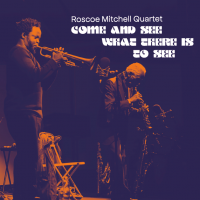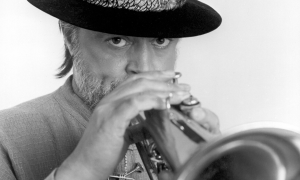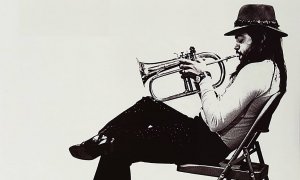Home » Jazz Articles » Catching Up With » Tigran Hamasyan: Music and Arts Have a Purpose to Elevat...
Tigran Hamasyan: Music and Arts Have a Purpose to Elevate People Spiritually

Courtesy Nonesuch Records
For his latest release The Call Within, (Nonesuch, 2020) he chose to let his soul shape the music, looking to art, maps from different eras, rock carvings, poetry, astrology, cinema and other arts for inspiration. The result is an astonishing journey into a rich and dreamlike innerworld and one of the most ambitious in his already boundary-breaking oeuvre. All of these experiments in content and form converge in interesting ways even though the compositions never stray from their core mission to deliver beautiful melodies and to maintain compositional integrity. The Call Within shows that the only constant about Hamasyan's career is that it's always evolving.
All About Jazz: The Call Within is a incredibly diverse record. Was it a challenge to make its myriad of various influences fit together?
Tigran Hamasyan: For each composition I write and each album I make the only challenge is to make it something personal and to constantly push myself to the horizon of new discoveries while staying true to what feels right in regards to where I stand at the moment as a composer and a performer. All my albums have sort of a continuity and the content of a lot of the compositions have been a working progress of years of developing ideas. For example, half of the melodies of the piece "VortԷx" was written in 2005 when I was still in college, but it took some years to develop and finally two years ago it felt like "this composition could be done and released into the world now."
AAJ: Please describe the ideas, concepts and emotions that drove the compositions on this record.
TH: The idea of this record was to record an album that consisted mostly of tunes written for my trio. I like telling stories and I like the idea of music having this narrative quality. It goes back to music being a way of telling a story, like religious music or like bebop as Barry Harris would teach that every phrase is like speaking and the composition is like telling a story. So in the case of this album every composition has this narrative quality and stories behind the tunes.
AAJ: The record is being released while the world is going through a global health crisis. How has the COVID-19 situation affected you?
TH: It's been pretty intense few months now of not being able to perform or travel but at the same time radical change can have a lot positive effect. It's like getting out of your comfort zone (or in some cases maybe being home too much thus getting tired of your comfort zone which make you realize your habits, your need of the "outside" while everything that is inside has been ignored... I have enjoyed being home with my family and actually it has been quite a prolific time because I am almost finishing a project that is probably the most intense and biggest project I have done so far and also I have prepared separate music for an acoustic jazz trio that I am planning on recording when it will be much safer to travel.
AAJ: During the lockdown period (sometime in April) you did an online concert from your home. What are your views on the importance of music connecting people during these challenging and difficult times we live in?
TH: I feel like music and arts have one purpose really, which is to elevate people spiritually and make them forget the material world, to dream, to go to that place within that has no boundaries and connects people on another level.
AAJ: When one looks upon your albums to date it is evident that you don't look at music with any sense of genre or dogmatic perspective. Can you describe the overall philosophy you bring to your work as a composer?
TH: What matters to me is the content of the music, it can be put in different boxes but the content is what makes the composer. I have been influenced and inspired by many different genres since my upbringing and this has an effect on me as a composer and a producer.
AAJ: The musical heritage of your native Armenia has proven to be an important and endless source of inspiration for you apart from jazz or other contemporary music or music from other corners of the world which are all part of your expression. How has the folk music from Armenia and its many traditions influenced your work to date?
TH: The musical tradition from Armenia is very diverse. It has a lot of genres in itself. It's a very large and deep topic to talk about how exactly Armenian music has influenced me but I will give you some examples. I feel like I have learned the meaning of melody through this music. Once you have an Armenian melody in front of you to to do a "modern" arrangement then things start getting real. It so to speak questions the very reason of your music making. I feel like until the end of my life I will try to find a way to arrange an Armenian melody. Once you have learned enough and dug deep enough to understand that this music (and all folk music of the world) is already there in its perfect form and doesn't really need any extra arrangement, then you are on the right track of possibly doing something to it that won't sound kitsch and actually downgrade the melody itself. I understood the importance of this melodic content and came to the conclusion that every action I take towards arrangement must come from the melody itself and not outside influences.
AAJ: How do you look back at Atmospheres (ECM, 2016) which was made with renowned Norwegian musicians and producers Jan Bang, Arve Henriksen, and Eivind Aarset? It was a leaderless collective and based on improvisations. Can you talk about the musical chemistry and the creative approach that you took that yielded that music?
TH: It was really special collaboration. Manfred Eicher asked Jan Bang and I to do a record and we decided to bring Arve and Eivind on board as well because we both had such a big connection to their sound. We got to the studio and honestly we had no clue of what we were going to play. The idea was that we would improvise freely and sometimes use Komitas' melodies as landing points. (Komitas was a renowned Armenian composer, ethnomusicologist, poet and a priest) The whole double album was recorded in 2 days and mixed the third day.
AAJ: You've been using Bandcamp a lot in recent times to put out music, starting from Mockroot (Nonesuch, 2016) up to The Call Within. Why is Bandcamp an optimal platform for these releases?
TH: Bandcamp is great because artists that are struggling to find a label can make their music available to their audience, but recently it became so popular that labels are putting it on Bandcamp as well, which says a lot about the current situation of record labels and artists as well.
AAJ: Since your debut World Passion (Nocturne, 2006) you have released many diverse records and collaborations. What evolution as a composer and pianist do you see across your albums to date?
My goal is to create a new world that can contain many small new worlds.
Tags
PREVIOUS / NEXT
Tigran Hamasyan Concerts
Support All About Jazz
 All About Jazz has been a pillar of jazz since 1995, championing it as an art form and, more importantly, supporting the musicians who make it. Our enduring commitment has made "AAJ" one of the most culturally important websites of its kind, read by hundreds of thousands of fans, musicians and industry figures every month.
All About Jazz has been a pillar of jazz since 1995, championing it as an art form and, more importantly, supporting the musicians who make it. Our enduring commitment has made "AAJ" one of the most culturally important websites of its kind, read by hundreds of thousands of fans, musicians and industry figures every month.





















